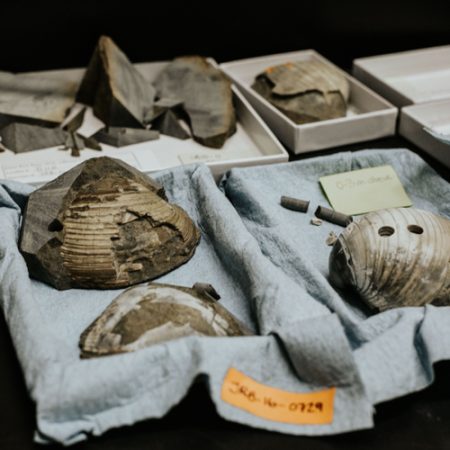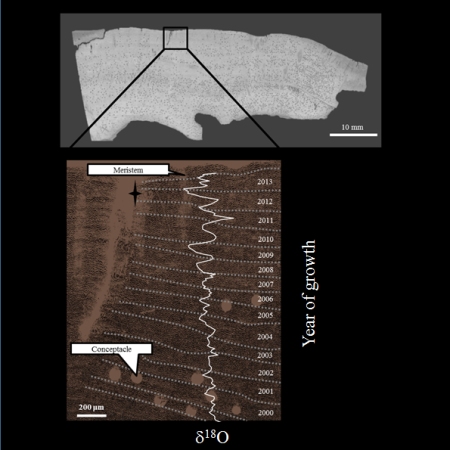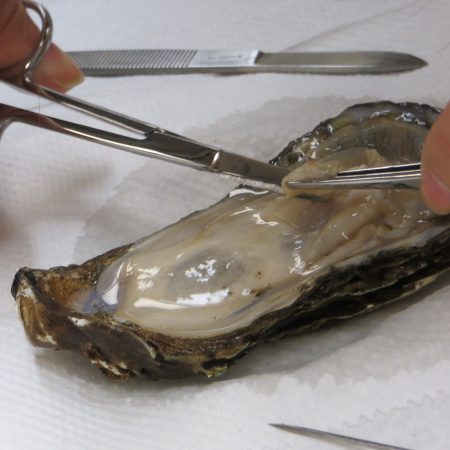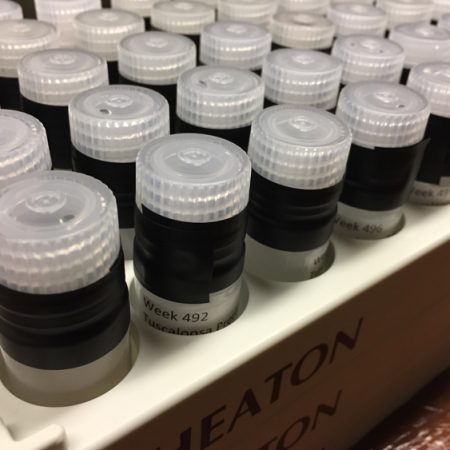Since 2005 ASIL has maintained a local rain gauge that provides δ18O and δD compositions for meteoric water at weekly resolution. These data have complemented a number of paleoclimate research projects in the region. Additionally, the continuous operation of this project has allowed several students (undergraduate and graduate) to be trained to properly collect the fluid and determine the isotopic composition.
Projects

Paleoclimatic and Paleoceanographic changes in the Antarctic Peninsula
Since the late 1970’s the Antarctic Peninsula has been subject to rapid warming, with the majority of its outlet glaciers receding. In order to understand these changes and the driving forces behind them, we reconstruct past glacial response to climatic and oceanic events during the Holocene through sedimentary, geochemical and biological analyses of sediments collected offshore Antarctica. We utilize grain size, carbon and nitrogen isotopes, and diatom microfossils as proxies of ocean productivity and climate change over the last 12,000 years. Integrating these proxies enables us to understand how glaciers have responded to climate and ocean variations in the past and improve predictions of future changes in the glacial landscape.

Paleoenvironments of Mobile Bay and Weeks Bay, AL
We are analyzing sediment cores from Mobile Bay and Weeks Bay, AL, we are analyzing sediment samples for δ13C, δ15N, TOC, and C:N in order to understand trends in productivity, processed organics, and source. Isotopic are compared to records of elemental abundances, microfossil populations, and grain size distribution to reconstruct the paleoenvironment and look for evidence of flood, storm, and eutrophication events throughout the Mid- to Late-Holocene. Ultimately, we hope to better understand the impact of climate change and human activity on these environments.

Ammonite Paleoecology
While ammonites are diverse and abundant in the fossil record, the lack of clear modern analogues makes interpretation of their lifestyle quite challenging. Nick Ellis, a former undergraduate at the University of Alabama, generated sequentially sampled isotopic profiles from ammonite shell carbonate. Periodicity in these records is indicative of seasonal variation, which may allow us to estimate the growth rate and age of these extinct organisms. Ongoing projects from Jessie McCraw, Sam Stanford, and Gozde Degirmen are pursuing other projects related to ammonite metabolism, living environment, and ecosystem position.

Speleothem paleoclimate records
I am advising and working with undergraduate students on a paleoclimate project based on samples and data from Cathedral Caverns (Alabama). Currently, we are studying freshly precipitated calcite from sand-blasted watch glasses that were placed under active drips in the cave. We are determining if a seasonal bias (winter vs. summer) exists for the calcite precipitation rates and speleothem isotopic composition (δ13C and δ18O) due to changes in cave air pCO2. The ultimate goal of this research is to improve interpretation of proxy records archived in the cave’s stalagmites.

Sedimentary carbon isotopic profiles of the K-Pg boundary in Montana
The K-Pg mass extinction is known to coincide with a major shift in the global carbon cycle, which is usually reflected in carbon isotopic values of most materials preserved from this time period. This isotope excursion is often used as a method of identifying or confirming the presence of the K-Pg boundary at a site. Along with an undergraduate student (Jacob Honeck) and collaborators at other institutions, we are working to determine if the carbon isotope signal from organic carbon can be identified reliably and consistently from a terrestrial depositional environment in the Hell Creek are of Montana. We have designed collection techniques to address the complicating factors of changing depositional environments and modern surface weathering.

Seasonality across the K-Pg boundary in Antarctica
We collected a suite of fossil clams from above and below the K-Pg boundary (66.5 – 65.5 Ma) on Seymour Island, Antarctica. Rachel Mohr (M.S., 2018) has been sampling these shells to generate isotopic profiles which can be used to assess the marine environment at this time. Through use of the computer controlled micromill, we can generate up to 20 samples per growth band, which represents one year of shell growth. By examining the isotope records at this resolution, we can reconstruct how the environment changed seasonally across this important geologic interval.

Stable oxygen isotope reconstruction of Greenland glacial melt
Former Ph.D. student Hillary Sletten, in collaboration with Jochen Halfar and his research group, analyzed a nearly century-long sub annually-resolved time series of δ18O in coralline algae that may record melt patterns in glaciers that fed a fjord in western Greenland.

Historic reconstructions of anthropogenic N-loading in estuaries
Measuring δ15N content in modern and ancient archaeological oysters from Chesapeake Bay over the past few centuries permitted reconstruction of how humans impacted the Bay beginning in at least the 1800’s. Former MS student Heather Black, in collaboration with the Smithsonian Institution’s Torrey Rick, published this work in Scientific Reports (2017 – doi:10.1038/srep44241). You can read more about it in Science Daily.
